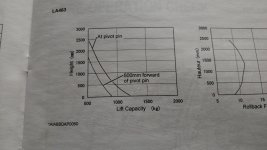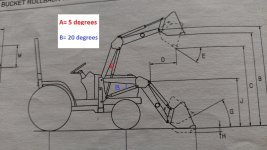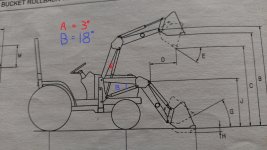I took a picture of the lift vs height graph in my manual and figured I share.
All loaders will have a similar curve, weather or not there is one in print somewhere.

Notice that at ground level, lift at the pins is in the 1200kg range (2640lbs) Which is over double its 1100lb rating to max height.
And the 500mm forward point (bucket edge) is in the 850kg range (1870lbs), again, alot more than its 850lb rating to full height.
To a height of about 1000mm (40" truck bed height) it looks to still be good to ~650kg(1430lbs) at 500mm bucket edge and ~800kg (1720lbs) Not hard to see why I can lift a 1200# pallet with clamp on forks to load in the bed of a truck, especially with my relief set 300psi over spec. And able to lift some pretty good logs just high enough to be out of the dirt to cut.
All this on a loader only rated for 850# at the bucket edge to max height.
Loader underrated? No. Just the geometry of the design and where the ratings are taken from. The MFG ratings IMO are probably pretty close. Just understand that it is able to lift alot more at lower heights.
This image shows the difference in angles from ground level to max height.

Since the formula for cylinders on an angle is the power of the cylinder times the sine of the angle
My cylinders are 1.77" diameter and factory spec is 2347psi each cylinder can push with 5775# of force, or 11,550# for the pair.
On an 20 degree cylinder to arm angle, only 0.342 (or 32.4%) of that is used for vertical force. That gives 3950# upward push at the cylinder mounts at ground level. (Loader cant actually lift that obviously, cause factors such as the dead weight of the bucket and frame, plus the leverage effect. Bucket is pretty far out in front of the cylinder pushing points.
At max height, the angle is closer to 5 degrees. Thats 0.087 (8.7%). So that 11,550# available translates into 1006# pushing vertically.
Those of you questioning the fact that as the loader goes higher, the movement becomes less vertical and more horizontal (travelling around the arc) and "should not" cause a reduction. THIS is your answer. The lift height vs capacity curve accounts for that. Notice that on the curve the lift capacity at the pin goes from ~1200kg down to 500kg. Thats a reduction of 58%. You have 58% less capacity at the top than at the bottom of the loaders range of travel.
All that was done though, while loosing 75% of its push from the cylinders.
So...loose 75% power out of the cylinders, only loose 58% of the lift capacity.
Any questions?





